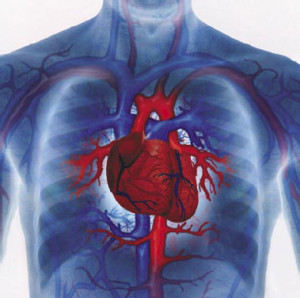- Calls to this hotline are currently being directed to Within Health or Eating Disorder Solutions
- Representatives are standing by 24/7 to help answer your questions
- All calls are confidential and HIPAA compliant
- There is no obligation or cost to call
- Eating Disorder Hope does not receive any commissions or fees dependent upon which provider you select
- Additional treatment providers are located on our directory or samhsa.gov
Bulimia and Cardiovascular Risk: What does the research show?

The hearts of patients with eating disorders may be atrophied, most commonly due to reduced blood volume and negative energy balance. Acute changes in cardiovascular function may precipitate cardiac arrest or failure and pose a persistent risk even during treatment.
Patients who have engaged in periods of prolonged restrictive eating may develop metabolic disturbances that occur as a result of reinstituting nutrition (re-feeding syndrome). This syndrome typically manifests with shifts in extracellular fluid (edema), low available energy and low phosphorus. Close monitoring is recommended due to an increased risk of arrhythmias, fast heart rates, congestive heart failure, and sudden cardiac death.
Bulimia Nervosa is characterized by recurrent binge-eating episodes followed by behaviors to prevent weight gain (purging). Those affected may develop habits of self-induced vomiting, excessive laxative use, or even misuse diuretics.
Repeated episodes of vomiting can result in dehydration, which will affect cardiovascular function leading to hypotension, postural pulse and blood pressure changes, and tachycardia. Changes in serum electrolytes are seen related to excessive gastrointestinal and renal (kidney) losses.
Low serum levels of potassium (hypokalemia), low levels of chloride, metabolic alkalosis (vomiting) and acidosis (laxatives) are common seen. The severity of metabolic disturbance is directly related to the number of purging episodes, but the body may adjust over time. Low levels of potassium (hypokalemia) associated with Bulimia Nervosa are found particularly in patients who are at lower weights, vomit, abuse laxatives, or both.
Potassium plays an important role in the electrochemical gradients involved in nerve and muscle activity. Specifically, low levels of potassium affect the gradient of polarization of the cardiac muscle cells delaying repolarization (prolonged QTC), which puts patients at risk for new arrhythmias. Patients may manifest symptomatically with palpitations and syncope (fainting).
The most severe, and fatal form of arrhythmia from hypokalemia is a ventricular tachycardia known as Torsade’s de Pointes. Patients can lose potassium from vomiting.
Laxative abuse can also cause loss of potassium in the stool. Some diuretics can cause loss of potassium via their effect on the kidneys’ filtration system. Purging can also cause volume depletion, leading to dizziness, low blood pressure, and syncope, or loss of consciousness.
Some patients self induce vomiting by ingesting ipecac, syrup previously used to treat toxic ingestion. It is estimated that 1-2% of women with eating disorders have regularly abused this medication.
Ipecac contains an active ingredient called emetine, which has a long half-life and can accumulate to toxic levels with repeated use. It causes irreversible damage to cardiac cells leading to cardiomyopathy with ventricular dysfunction, congestive heart failure, ventricular arrhythmias, and even sudden cardiac death.
Binge and purge behavior also has an impact on the cardiovascular response to stress. One way to evaluate the stress response and function of the autonomic nervous system is to measure heart rate variability.
Patients with bulimia nervosa show high heart rate stress reactivity. Patients with both anorexia nervosa and bulimia nervosa display abnormal sympathetic-vagal control of their heart rate variability as measured by a tilt-table test with impaired sympathetic activation and prominent vagal activity.
This dis-regulation of heart rate and blood pressure can lead to inadequate blood flow to the organs, especially the brain, and can cause vasovagal syncope or a temporary loss of consciousness. Patients with bulimia nervosa should be monitored for these cardiovascular complications. Even during recovery, patients with bulimia nervosa experience effects on their cardiovascular health.
While these cardiac complications are known, it is far less clear how aggressively practitioners should screen for complications with bulimia or monitor for ongoing risk after initial diagnosis. A screening Electrocardiogram (EKG) is recommended and may be helpful in patients with frequent purging, electrolyte abnormalities or low body weight.
It is also prudent to obtain an EKG if patients are taking new medications with known effects on cardiac conduction or if patients complain of palpitations or chest pain. Patients with a history of structural cardiac abnormalities, ipecac use, EKG abnormalities, weakness, edema, or heart murmurs may be candidates for echocardiography.

Hypokalemia, however, occurs in only 4.6% of patients making it difficult to predict which patients will be at risk. We suggest checking electrolytes and postural vital signs (blood pressure and pulse) regularly in patients who continue to purge daily, in adolescents, in those who have recently struggled with more frequent purging, and in those who have significant signs and symptoms of dehydration or a history of electrolyte abnormalities.
Medical clearance guidelines for driving and sport participation are not universally agreed upon. Certainly, the clinician should consider cardiovascular risk factors and evaluate thoroughly before giving any green light to rigorous activity.
Research suggests that best practice would include thoughtful regular assessment of cardiovascular function and risk in patients with bulimia nervosa typically including a screening EKG, monitoring of electrolytes, physical exam and frequent assessment of vital signs. More intensive medical monitoring is likely warranted in a subset of patients with increased risk.
About the Author:
Dr. McCallum is based in St. Louis, but also is licensed in the state of the state of Kansas and will help train and supervision all of the medical and clinical staff. Dr. McCallum is a psychiatrist, board certified in both child, adolescent, and in adult psychiatry. She is a fellow of the American Psychiatric Association (FAPA) and a Certified Eating Disorders Specialist (CEDS) and remains an Associate Professor of Clinical Psychiatry at Washington University. She received her Bachelor of Science from Brown University, her medical degree from Yale University, completed her adult training at UCLA Neuropsychiatric Institute, and her Child and Adolescent Psychiatry Fellowship at Washington University School of Medicine. This year she is the recipient of the 2015 C. Johnson Award for Excellence in clinical Practice and Training from the National Eating Disorder Association.
Sponsored by McCallum Place Eating Disorders Centers.
McCallum Place Eating Disorder Centers are nationally acclaimed, comprehensive eating disorder treatment centers for adolescents, adults, males and females.
The opinions and views of our guest contributors are shared to provide a broad perspective on eating disorders. These are not necessarily the views of Eating Disorder Hope, but an effort to offer a discussion of various issues by different concerned individuals.
We at Eating Disorder Hope understand that eating disorders result from a combination of environmental and genetic factors. If you or a loved one are suffering from an eating disorder, please know that there is hope for you, and seek immediate professional help.
Published October 22, 2015, on EatingDisorderHope.com
Last Reviewed & Approved on February 18, 2020, by Jacquelyn Ekern MS, LPC


